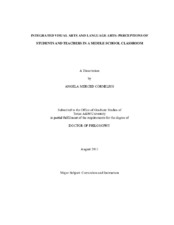| dc.contributor.advisor | Slattery, Patrick | |
| dc.contributor.advisor | Carpenter, B. Stephen | |
| dc.creator | Cornelius, Angela Merced | |
| dc.date.accessioned | 2012-10-19T15:29:36Z | |
| dc.date.accessioned | 2012-10-22T18:06:20Z | |
| dc.date.available | 2012-10-19T15:29:36Z | |
| dc.date.available | 2012-10-22T18:06:20Z | |
| dc.date.created | 2011-08 | |
| dc.date.issued | 2012-10-19 | |
| dc.date.submitted | August 2011 | |
| dc.identifier.uri | https://hdl.handle.net/1969.1/ETD-TAMU-2011-08-10173 | |
| dc.description.abstract | The overarching problems to which this study responds are the inadequacies of a traditional language arts curriculum for underserved middle school students and the ways such curricula fall short in providing these students viable means to succeed both academically and socially. The purpose of this study was to learn what happens when underserved middle school students were simultaneously engaged in literacy studies and visual arts learning based on the perceptions of four students, their teacher and the researcher.
The questions that guided this study of an integrated literacy curriculum in a visual arts classroom were: 1) What were the perceptions of four underserved middle school students regarding their participation in an arts and literacy integrated curriculum? 2) What were the perceptions of a middle school teacher about student participation arts and literacy integrated curriculum? and, 3) What were the perceptions of the researcher who participated in arts and literacy integrated curriculum?
This study incorporated ethnographic techniques of observation, interviews, and artifact collection and analysis as a basis for assessing and interpreting evaluating the real world experiences of students and a teacher. By using a case study methodology along with elements of autoethnography, the study explored primarily the perceptions of four underserved students, along with casual interaction with 24 other students, in class as they engaged in literacy activities in the art class.
Results illustrate the students did not find the writing assignment relevant to the associated art activity. Although some students disliked the literacy exercise, some professed to understand its value. Most deemed it irrelevant or inappropriate. All preferred to only work on their art projects.
The veteran teacher expressed interest in incorporating language arts into the art class but only did so on a limited basis. It appeared to the researcher that the potential for increasing verbal literacy was likely hampered by inadequate preparation for the lesson. The teacher may not have had a deep belief or motivation to fully utilize this technique. The potential for students to be exposed to deeper literacy integration in the arts class may not have been fully realized. | en |
| dc.format.mimetype | application/pdf | |
| dc.language.iso | en_US | |
| dc.subject | Integrated curriculum | en |
| dc.subject | Language arts integration | en |
| dc.subject | art integration | en |
| dc.title | Integrated Visual Arts and Language Arts: Perceptions of Students and Teachers in a Middle School Classroom | en |
| dc.type | Thesis | en |
| thesis.degree.department | Teaching, Learning, and Culture | en |
| thesis.degree.discipline | Curriculum and Instruction | en |
| thesis.degree.grantor | Texas A&M University | en |
| thesis.degree.name | Doctor of Philosophy | en |
| thesis.degree.level | Doctoral | en |
| dc.contributor.committeeMember | Lewis, Chance | |
| dc.contributor.committeeMember | Larke, Patricia | |
| dc.type.genre | thesis | en |
| dc.type.material | text | en |


